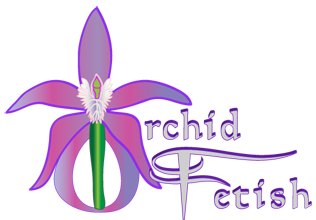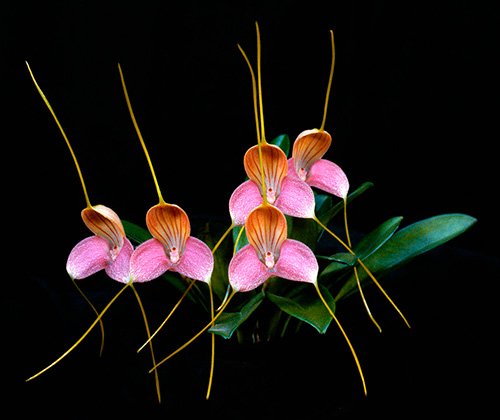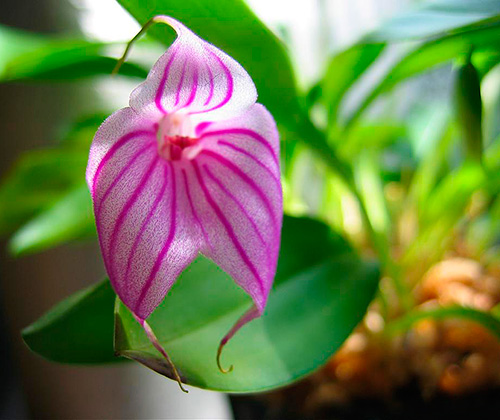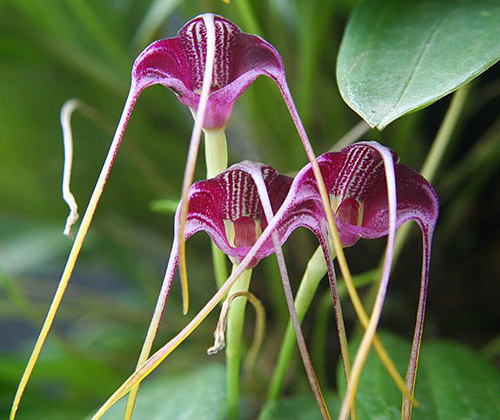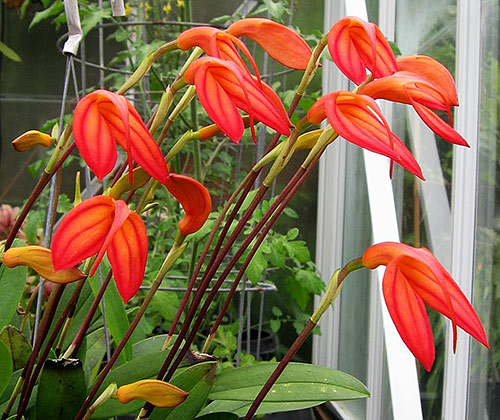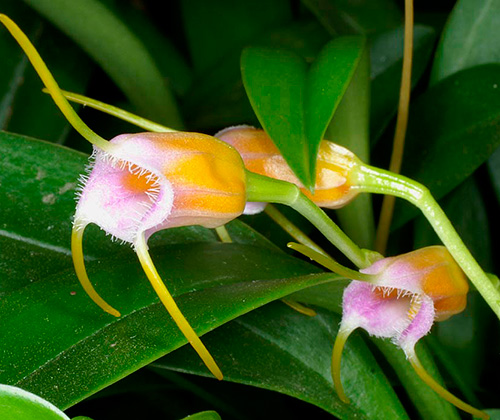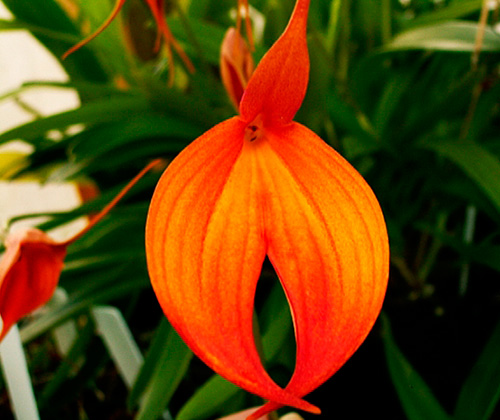Masdevallia Orchid
The Kite Orchid
The Masdevallias and Draculas grow throughout Central and South America and can be found as far north as southern Mexico and southward to Peru. Called Kite Orchids, Masdevallias resemble kites in flight. They are, for the most part, cool growers and can be found at high elevations in the mountainous cloud forests where they thrive on the high humidity. Some grow right at the snowline; it is not uncommon to see them become lightly dusted with fast melting snow. Still others grow in warmer and somewhat drier conditions where the plants do get some drying between rains. The colors and flower shapes are mind-boggling. Some of the hybrids have been found to have more vigor, making them easier to grow and bloom while retaining the intriguing colors and shapes.Flower spikes emerge at the bases of the leaves. It’s very easy to multiply your plant. All you have to do is to pull the clump apart. Just make sure that each division has at least 5 or 6 stems and has sufficient root system attached to support it. Moreover, the appropriate time to divide your orchid is in the winter, without the stress of the hot weather. This allows your plant to recuperate quickly and establish itself.
Light
In nature, these plants grow in areas that are very shady, around 1200 foot-candles (phalaenopsis light) and also in areas with fairly high light, in excess of 3500 foot-candles. Plants with heavier, thicker leaves generally need more light (cattleya light). Those with softer, thinner leaves prefer shadier conditions. Be careful in the summer not to overexpose the plants to light.Light should be like that given for phalaenopsis and paphiopedilums —1,000 to 1,500 foot-candles. Masdevallias can be kept in light intensities up to 2,500 foot-candles if the growing area can be kept cool. Plants grow well under standard fluorescent fixtures and can be summered outside in shade. In the home, place in an east or shaded south window or under artificial lights.
Temperature
should be cool to intermediate. The plants will grow slowly and eventually expire if temperatures remain high for long periods. Cool evenings help reduce heat stress during the day. Nights of 55 to 60 F are ideal; day temperatures should be 65 to 75 F. Evaporative cooling pads or humidifiers are useful in maintaining these conditions. Avoid day temperatures higher than 80 F. There are a few Masdevallias that do well in warmer areas where summer night temperatures infrequently fall below 68-70 degrees F. They are Masdevallia floribunda, striatella, kuhniorum, bicolor infracta, rima rima alba, bangii, minuta, attenuata, and echo. Other Masdevallias, including Draculas, prefer night temperatures from 40-60 °F. and day temperatures not reaching much above 75-80 °F. Remember, the colder you grow them, the sturdier the plants will be. Also, flowers will develop over a slower period giving you a larger size bloom as well as better color and shape. During summer it is almost inevitable that there will be some hot spells, sometimes lasting several weeks. When this occurs the plants will be stressed. Keep the plants shaded, reducing leaf temperatures.
Water
an important factor in the successful culture of masdevallias. The ideal range is 60 to 80 percent. In the home, set the plants on trays of gravel partially filled with water. In the greenhouse or enclosed growing area, humidity can be increased by use of a humidifier, while evaporative coolers help raise humidity and lower temperatures. If plants are summered outdoors, automatic misters underthe benches are recommended as is more frequent soaking. This is critical for these plants because they have minimal water-storage tissue. Roots should be allowed to become almost dry before watering again; if drainage is adequate, constantly moist roots are fine. Good-quality water low in dissolved solids is imperative for success. Like all orchids, Masdevallias and Draculas like clean water. Only distilled, rain water or reverse osmosis water should be used. If you examine their roots you will discover many fine hairs similar to root structures on Paphiopedilums. It is best to water these plants as they approach dryness. Thick, heavy-leafed plants prefer a little dryness at the roots. Thin soft-leafed varieties do not, unless there is heat stress as mentioned earlier. .
Humidity
Keep the humidity high, at least 70%, and provide plenty of air movement. We have found that if you keep the plants drier at the roots during hot spells you will avoid stem rot, which can occur very quickly and devastate newer growth and sometimes the entire plant. Misting the leaves lightly will keep them from shriveling. Once temperatures begin to cool off, resume regular watering. Very often during stressful heat waves you will notice, especially with Draculas, some leaf tips turning brown or becoming lightly spotted. This is generally stress-related and will stop once normal conditions resume. In greenhouses, grow the plants as close to the evaporative coolers as you can. If you don't have a greenhouse, grow your plants in an air-conditioned room or in a basement under lights.
Fertilizer
Fertilize regularly with a dilute solution while plants are actively growing. Applications of 30-10-10-type formulations twice a month are ideal for plants in a bark-based medium. A 20-20-20-type formulation should be used for plants in other media. If weather is overcast, applications once a month are sufficient. Moreover, they dislike water with high dissolved minerals, so go easy on the fertilizer (monthly at a quarter of the strength) and flush out the potting medium thoroughly every time you water. For tap or well water, fertilize lightly at ¼ to ½ strength Grow More 20-10-20 every two to three weeks.
Potting
The best medium for these plants to our knowledge is New Zealand sphagnum moss. best done in the winter or early spring, before the heat of summer arrives or as new roots are produced. Plants must be repotted frequently, every one to two years, before the potting mix decomposes. A fine-grade potting medium, such as fine fir bark or tree-fern fiber, is often used with plastic pots. Sphagnum moss is also used, especially for establishing plants. The plant should be positioned in the pot so that the newest growth is farthest from the edge of the container, allowing the maximum number of new growths without crowding the vessel. Plants growing in many directions may be positioned in the center of the pot. Spread the roots over a cone of potting medium and fill in around the roots with potting medium to the junction of the roots and the plant. Firm the medium around the roots. Keep humidity high and the potting medium slightly dry until new roots form.When using sphagnum it is important to check for mix decomposition after 9 months to a year and repot if necessary. Bark mixes also work, but they tend to dry out very quickly, especially in the summer. Sphagnum holds an incredible amount of water, yet remains springy allowing air to pass through the medium. It is very easy to check your root systems in sphagnum because you can pull out the root mass that is holding the moss together.
